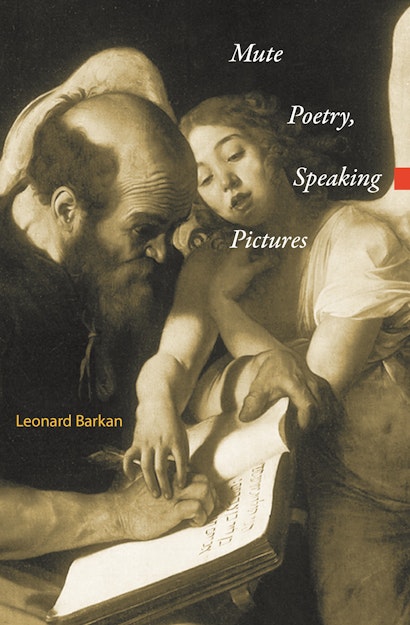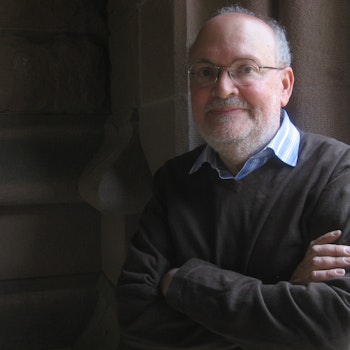Why do painters sometimes wish they were poets—and why do poets sometimes wish they were painters? What happens when Rembrandt spells out Hebrew in the sky or Poussin spells out Latin on a tombstone? What happens when Virgil, Ovid, or Shakespeare suspend their plots to describe a fictitious painting? In Mute Poetry, Speaking Pictures, Leonard Barkan explores such questions as he examines the deliciously ambiguous history of the relationship between words and pictures, focusing on the period from antiquity to the Renaissance but offering insights that also have much to say about modern art and literature.
The idea that a poem is like a picture has been a commonplace since at least ancient Greece, and writers and artists have frequently discussed poetry by discussing painting, and vice versa, but their efforts raise more questions than they answer. From Plutarch (“painting is mute poetry, poetry a speaking picture”) to Horace (“as a picture, so a poem”), apparent clarity quickly leads to confusion about, for example, what qualities of pictures are being urged upon poets or how pictorial properties can be converted into poetical ones.
The history of comparing and contrasting painting and poetry turns out to be partly a story of attempts to promote one medium at the expense of the other. At the same time, analogies between word and image have enabled writers and painters to think about and practice their craft. Ultimately, Barkan argues, this dialogue is an expression of desire: the painter longs for the rich signification of language while the poet yearns for the direct sensuousness of painting.
Awards and Recognition
- One of Choice's Outstanding Academic Titles for 2013
"Barkan (Michelangelo: A Life on Paper) fruitfully illustrates that 'word and image, poetry and painting, language and visuality are the oppositions upon which artistic theory and practice have been stretched.' Barkan's splendid meditations take us from Plutarch, who believed that 'painting is mute poetry, poetry a speaking picture,' through Horace, examining to the art and poetry of early modern Europe. . . . In his rich and detailed musings on this ongoing debate in the history of ideas, Barkan concludes, as Shakespeare does, that 'even when we insist that poetry and painting lie separately, it turns out they lie together.'"—Publishers Weekly
"[E]rudite and wide-ranging."—Michael Dirda, Washington Post
"This deeply learned essay by Barkan, one of the great contemporary American scholars of the Renaissance, deserves to become a standard work on the relations of word, image, and poetry and painting in pre-modern culture. Over the course of four chapters, Barkan offers lucid, often humorous expositions of the key concept of mimesis and the practice of ekphrasis as meditations on them evolved over centuries from Plato and Pliney to Albertia and Vasari."—Choice
"This is an impressive, challenging, highly innovative study on a subject that we thought we knew by heart: the relationships, either pacific or antagonistic, between words and images. . . . At first sight, Barkan's approach combines the best of historical criticism and deconstruction, which is already quite an achievement in itself, but the most admirable quality of his analyses is both the tightening and the broadening of this age-old debate. On the one hand, Mute Poetry, Speaking Pictures brings together a wide range of works, authors, sources, interpretations, debates, and concepts that are most of the times separated or only partially covered in most historical overviews. . . . The power that drives his book from the first till the last line is the desire to compare apples and oranges, and the skepticism that arises when apples and oranges are put aside in different baskets."—Jan Baetens, Leonardo on-line
"Like an oil well kissed by Midas, Leonard Barkan keeps on pumping gold. . . . Even after fifty years of scholarship and theorizing about words and pictures, this book will be indispensable to anyone who wants to understand not just the relations between the two, but the fascinating history of those relations in poetry, theory, and visual art itself."—James A. W. Heffernan, Renaissance Quarterly
"Mute Poetry, Speaking Pictures provides an excellent contribution to the growing body of work over recent years on the history and theory of ekphrasis. It reflects the increasing fascination among poets, critics and academics with the relationship of literary texts to the visual arts."—Peter Gillies, Stride
"In this inspired book, Leonard Barkan traces the origins and transformations of the word-image conundrum in art and literature from Plato to Shakespeare, providing a deeply learned and often brilliant meditation on a central theme of contemporary aesthetics and cultural history. This is vintage Barkan—a seductive book, written with eloquence and insight, and giving much pleasure and intellectual profit."—Marvin Trachtenberg, Institute of Fine Arts, New York University
"Vibrant, insightful, and elegantly written, this book reflects a lifetime of thought by a master of his subject."—Jaś Elsner, University of Oxford and University of Chicago
"A dazzling display of erudition spiced with humor and rhetorical wizardry, this book will interest anyone who cares about pictures or words—and what else is there?"—Michael Ann Holly, Sterling and Francine Clark Art Institute


